Greenhouse Gas Emissions from Agriculture in EU Countries—State and Perspectives
Abstract
:1. Introduction
2. Materials and Methods
3. Results and Discussion
3.1. GHG Emissions in the EU
3.2. Agricultural GHG Emission in the EU
3.3. State of Reduction of Agricultural GHG Emissions in the EU
3.4. GHG Emissions from Main Agricultural Sources
3.4.1. Enteric Fermentation
3.4.2. Manure Management
3.4.3. Agricultural Soils
3.4.4. Field Burning of Agricultural Residues
3.4.5. Liming
3.4.6. Urea Application
4. Conclusions
Author Contributions
Funding
Institutional Review Board Statement
Informed Consent Statement
Data Availability Statement
Conflicts of Interest
References
- Kweku, D.; Bismark, O.; Maxwell, A.; Desmond, K.; Danso, K.; Oti-Mensah, E.; Quachie, A.; Adormaa, B. Greenhouse Effect: Greenhouse Gases and Their Impact on Global Warming. J. Sci. Res. Rep. 2018, 17, 1–9. [Google Scholar] [CrossRef]
- Cofała, J.; Amann, M.; Asman, W.; Bertok, I.; Heyes, C.; Höglund-Isaksson, L.; Klimont, Z.; Schöpp, W.; Wagner, F. Integrated Assessment of Air Pollution and Greenhouse Gases Mitigation in Europe. Arch. Environ. Prot. 2010, 36, 29–39. [Google Scholar]
- Le Treut, H.; Somerville, R.; Cubasch, U.; Ding, Y.; Mauritzen, C.; Musset, A.; Peterson, T.; Prather, M. Historical Overview of Climate Change. In Climate Change 2007: The Physical Science Basis. Contribution of Working Group I to the Fourth Assessment Report of the Intergovernmental Panel on Climate Change; Solomon, S., Qin, D., Manning, M., Chen, Z., Marquis, M., Averyt, K.B., Tignor, M., Miller, H.L., Eds.; Cambridge University Press: Cambridge, UK, 2007. [Google Scholar]
- Valipour, M.; Bateni, S.M.; Jun, C. Global Surface Temperature: A New Insight. Climate 2021, 9, 81. [Google Scholar] [CrossRef]
- Nijsse, F.J.; Cox, P.M.; Huntingford, C.; Williamson, M.S. Decadal Global Temperature Variability Increases Strongly with Climate sensitivity. Nat. Clim. Chang. 2019, 9, 598–601. [Google Scholar] [CrossRef]
- Eurostat. The Source Data for GHG Emissions. 2020. Available online: http://ec.europa.eu/eurostat/data/database (accessed on 12 December 2020).
- Schimel, D.; Alves, D.; Enting, I.; Heimann, M. Chapter 2: Radiative Forcing of Climate Change. In Climate Change 1995: The Science of Climate Change. Contribution of Working Group I to the Second Assessment Report of the Intergovernmental Panel on Climate Change; Houghton, J.T., Meira Filho, L.G., Callander, B.A., Harris, N., Kattenberg, A., Maskell, K., Eds.; Press Syndicate of the University of Cambridge: Cambridge, UK, 1996. [Google Scholar]
- Myhre, G.; Shindell, D.; Bréon, F.-M.; Collins, W.; Fuglestvedt, J.; Huang, J.; Koch, D.; Lamarque, J.-F.; Lee, D.; Mendoza, B.; et al. Anthropogenic and Natural Radiative Forcing. In Climate Change 2013: The Physical Science Basis. Contribution of Working Group I to the Fifth Assessment Report of the Intergovernmental Panel on Climate Change; Stocker, T.F., Qin, D., Plattner, G.-K., Tignor, M., Allen, S.K., Boschung, J., Nauels, A., Xia, Y., Bex, V., Midgley, P.M., Eds.; Cambridge University Press: Cambridge, UK, 2013. [Google Scholar]
- Prather, M.J.; Holmes, C.D.; Hsu, J. Reactive greenhouse gas scenarios: Systematic exploration of uncertainties and the role of atmospheric chemistry. Geophys. Res. Lett. 2012, 39, L09803. [Google Scholar] [CrossRef] [Green Version]
- COM. Communication from the Commission to the European Parliament, the Council, the European Economic and Social Committee and the Committee of the Regions. 20 20 by 2020 Europe’s Climate Change Opportunity. Available online: https://eur-lex.europa.eu/legal-content/EN/TXT/?uri=COM:2008:0030:FIN (accessed on 12 December 2020).
- PE. Decision No 406/2009/EC of the European Parliament and of the Council of 23 April 2009 on the Effort of Member States to Reduce Their Greenhouse Gas Emissions to Meet the Community’s Greenhouse Gas Emission Reduction Commitments Up to 2020. Available online: https://eur-lex.europa.eu/legal-content/EN/TXT/?uri=CELEX:32009D0406 (accessed on 12 December 2020).
- COM. Communication from the Commission to the European Parliament, the Council, the European Economic and Social Committee and the Committee of the Regions. A Policy Framework for Climate and Energy in the Period from 2020 to 2030. Available online: https://eur-lex.europa.eu/legal-content/EN/ALL/?uri=celex%3A52014DC0015 (accessed on 12 December 2020).
- EEA. European Environment Agency. 2020. Available online: https://www.eea.europa.eu/data-and-maps/data/data-viewers/greenhouse-gases-viewer (accessed on 12 December 2020).
- IPCC. IPCC Guidelines for National Greenhouse Gas Inventories. 2006. Available online: https://www.ipcc-nggip.iges.or.jp/public/2006gl (accessed on 12 December 2020).
- Syp, A. Greenhouse Gas Emissions from Agriculture in 1990–2014. Zeszyty Naukowe Szkoły Głównej Gospodarstwa Wiejskiego w Warszawie. Problemy Rolnictwa Światowego 2017, 17, 244–255. [Google Scholar] [CrossRef]
- Kiefer, L.; Menzel, F.; Bahrs, E. The effect of feed demand on greenhouse gas emissions and farm profitability for organic and conventional dairy farms. J. Dairy Sci. 2014, 97, 7564–7574. [Google Scholar] [CrossRef] [Green Version]
- Rotz, A.C. Modeling greenhouse gas emissions from dairy farms. J. Dairy Sci. 2017, 101, 6675–6690. [Google Scholar] [CrossRef] [PubMed]
- Capper, J.L.; Cady, R.A. The effects of improved performance in the U.S. dairy cattle industry on environmental impacts between 2007 and 2017. J. Anim. Sci. 2020, 98, 1–14. [Google Scholar] [CrossRef]
- Rendon-Huerta, J.A.; Pinos-Rodriguez, J.; Kebreab, E. Animal nutrition strategies to reduce greenhouse gas emissions in dairy cattle. Acta Univ. 2018, 28, 34–41. [Google Scholar] [CrossRef]
- Hammond, K.J.; Humphries, D.J.; Crompton, L.A.; Green, C.; Reynolds, C.K. Methane emissions from cattle: Estimates from short-term measurements using a GreenFeed system compared with measurements obtained using respiration chambers or sulphur hexafluoride tracer. Anim. Feed. Sci. Technol. 2015, 203, 41–52. [Google Scholar] [CrossRef]
- O’Brien, D.; Geoghegan, A.; McNamara, K.; Shalloo, L. How can grass-based dairy farmers reduce the carbon footprint of milk? Anim. Prod. Sci. 2016, 56, 495–500. [Google Scholar] [CrossRef]
- Van der Weerden, T.; Beukes, P.; De Klein, C.; Hutchinson, K.; Farrell, L.; Stormink, T.; Romera, A.; Dalley, D.; Monaghan, R.; Chapman, D.; et al. The Effects of System Changes in Grazed Dairy Farmlet Trials on Greenhouse Gas Emissions. Animals 2018, 8, 234. [Google Scholar] [CrossRef] [PubMed] [Green Version]
- Fournel, S.; Pelletier, F.; Godbout, S.; Lagacé, R.; Feddes, J. Greenhouse Gas Emissions from Three Cage Layer Housing Systems. Animals 2012, 2, 1–15. [Google Scholar] [CrossRef] [PubMed] [Green Version]
- Philippe, F.X.; Nicks, B. Review on greenhouse gas emissions from pig houses: Production of carbon dioxide, methane and nitrous oxide by animals and manure. Agric. Ecosyst. Environ. 2015, 199, 10–25. [Google Scholar] [CrossRef] [Green Version]
- Samsonstuen, S.; Åby, B.A.; Crosson, P.; Beauchemin, K.A.; Aass, L. Mitigation of greenhouse gas emissions from beef cattle production systems. Acta Agric. Scand. Sect. A—Anim. Sci. 2020, 69, 220–232. [Google Scholar] [CrossRef]
- Witkowska, D.; Korczyński, M.; Koziel, J.; Sowińska, J.; Chojnowski, B. The Effect of Dairy Cattle Housing Systems on the Concentrations and Emissions of Gaseous Mixtures in Barns Determined by Fourier-Transform Infrared Spectroscopy. Ann. Anim. Sci. 2020, 20, 1487–1507. [Google Scholar] [CrossRef]
- Kupper, T.; Häni, C.; Neftel, A.; Kincaid, C.; Bühler, M.; Amon, B.; Van der Zaag, A. Ammonia and greenhouse gas emissions from slurry storage—A review. Agric. Ecosyst. Environ. 2020, 300, 106963. [Google Scholar] [CrossRef]
- Amon, B.; Kryvoruchko, V.; Amon, T. Influence of different methods of covering slurry stores on greenhouse gas and ammonia emissions. Int. Congr. Ser. 2006, 1293, 315–318. [Google Scholar] [CrossRef]
- Shimizu, M.; Satoru, M.; Desyatkin, A.R.; Jin, T.; Hata, H.; Hatano, R. The effect of manure application on carbon dynamics and budgets in a managed grassland of Southern Hokkaido, Japan. Agric. Ecosyst. Environ. 2009, 130, 31–40. [Google Scholar] [CrossRef]
- Smith, K.; Watts, D.; Way, T.; Torbert, H.; Prior, S. Impact of Tillage and Fertilizer Application Method on Gas Emissions in a Corn Cropping System. Pedosphere 2012, 22, 604–615. [Google Scholar] [CrossRef]
- Duncan, E.W.; Dell, C.J.; Kleinman, P.J.A.; Beegle, D.B. Nitrous Oxide and Ammonia Emissions from Injected and Broadcast—Applied Dairy Slurry. J. Environ. Qual. 2017, 46, 36–44. [Google Scholar] [CrossRef] [PubMed]
- Statuto, D.; Picuno, P. Improving the greenhouse energy efficiency through the reuse of agricultural residues. Acta Hortic. 2017, 1170, 501–508. [Google Scholar] [CrossRef]
- Algieri, A.; Andiloro, S.; Tamburino, V.; Zema, D.A. The potential of agricultural residues for energy production in Calabria (Southern Italy). Renew. Sustain. Energy Rev. 2019, 104, 1–14. [Google Scholar] [CrossRef]
- Viaene, J.; Van Lancker, J.; Vandecasteele, B.; Willekens, K.; Bijttebier, J.; Ruysschaert, G.; De Neve, S.; Reubens, B. Opportunities and barriers to on-farm composting and compost application: A case study from northwestern Europe. Waste Manag. 2016, 48, 181–192. [Google Scholar] [CrossRef]
- Bedoić, R.; Ćosić, B.; Duić, N. Technical potential and geographic distribution of agricultural residues, co-products and by-products in the European Union. Sci. Total Environ. 2019, 686, 56–579. [Google Scholar] [CrossRef] [PubMed]
- Page, K.L.; Allen, D.E.; Dalal, R.C.; Slattery, W. Processes and magnitude of CO2, CH4, and N2O fluxes from liming of Australian acidic soils: A review. Aust. J. Soil Res. 2019, 47, 747–762. [Google Scholar] [CrossRef]
- Barton, L.; Gleeson, D.B.; Maccarone, L.D.; Zúñiga, L.P.; Murphy, D.V. Is Liming Soil a Strategy for Mitigating Nitrous Oxide Emissions from Semi-arid Soils? Soil Biol. Biochem. 2013, 62, 28–35. [Google Scholar] [CrossRef]
- Hénault, C.; Bourennane, H.; Ayzac, A.; Ratié, C.; Saby, N.P.A.; Cohan, J.-P.; Eglin, T.; Le Gall, C. Management of soil pH promotes nitrous oxide reduction and thus mitigates soil emissions of this greenhouse gas. Sci. Rep. 2019, 9, 20182. [Google Scholar] [CrossRef] [Green Version]
- Watson, C.J. Urease activity and inhibition—Principles and practice. In Proceedings of the International Fertiliser Society, York, UK, 1 April 2000. [Google Scholar]
- Krasuska, E.; Pudełko, R.; Faber, A.; Jarosz, Z.; Borzęcka-Walker, M.; Syp, A.; Kozyra, J. Optimization and risk analysis of greenhouse gas emissions depending on yield and nitrogen rates in winter wheat cultivation. J. Food Agric. Environ. 2013, 11, 2217–2219. [Google Scholar]
- Byrne, M.P.; Tobin, J.T.; Forrestal, P.J.; Danaher, M.; Nkwonta, C.G.; Richards, K.; Cummins, E.; Hogan, S.A.; O’Callaghan, T.F. Urease and Nitrification Inhibitors—As Mitigation Tools for Greenhouse Gas Emissions in Sustainable Dairy Systems: A Review. Sustainability 2020, 12, 6018. [Google Scholar] [CrossRef]
- Xie, Y.; Tang, L.; Han, Y.L.; Yang, L.; Xie, G.X.; Peng, J.W.; Tian, C.; Zhou, X.; Liu, Q.; Rong, X.M.; et al. Reduction in nitrogen fertilizer applications by the use of polymer-coated urea: Effect on maize yields and environmental impacts of nitrogen losses. J. Sci. Food Agric. 2019, 99, 2259–2266. [Google Scholar] [CrossRef] [PubMed]
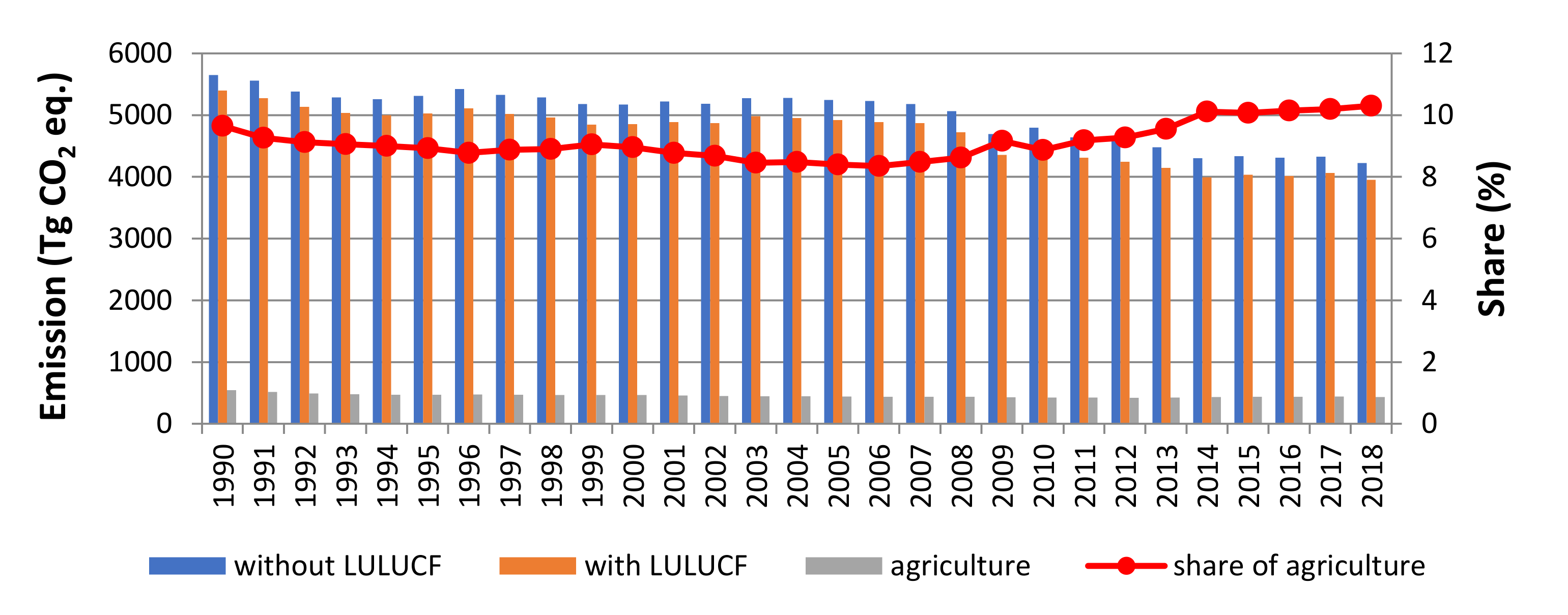
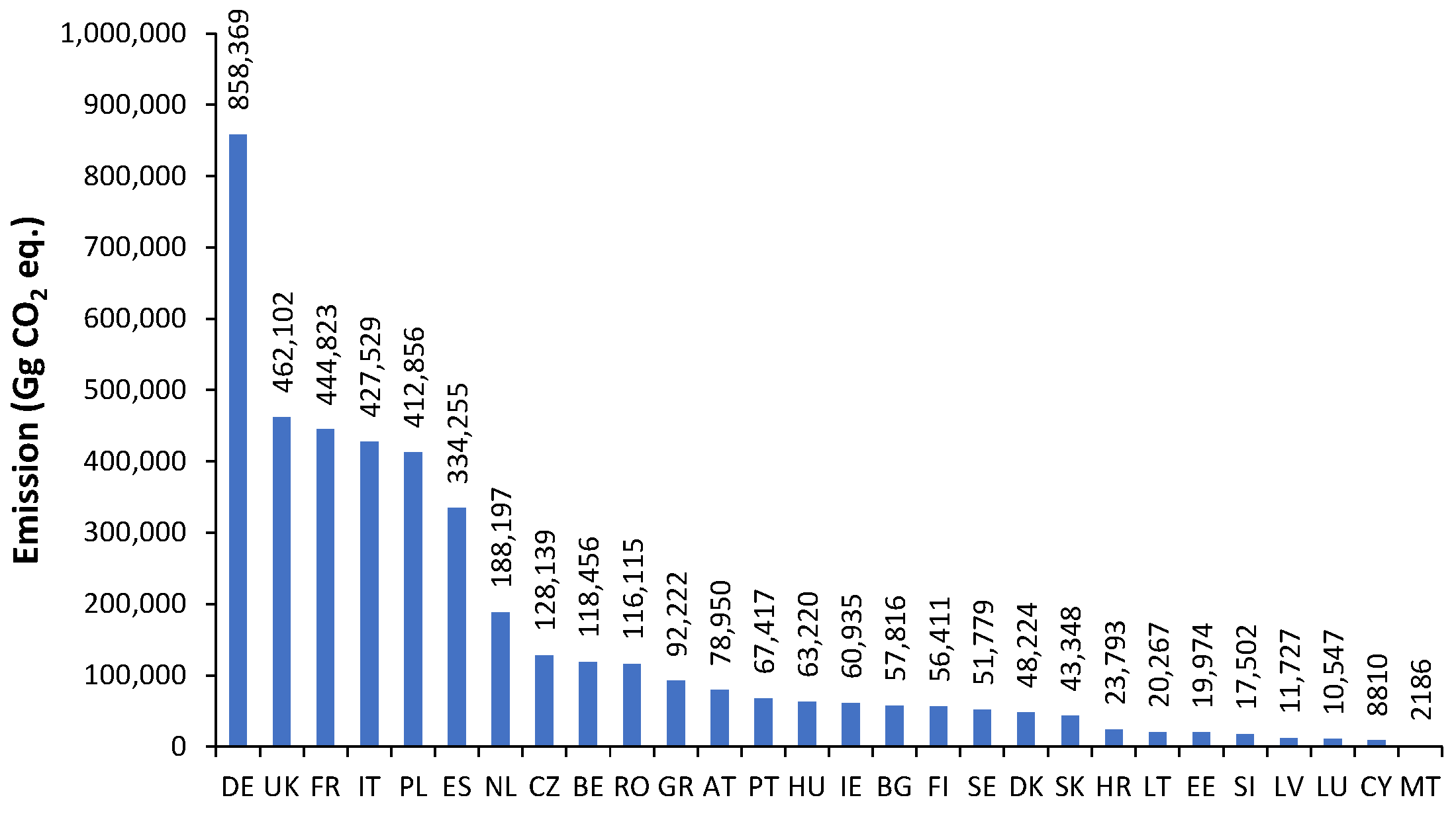
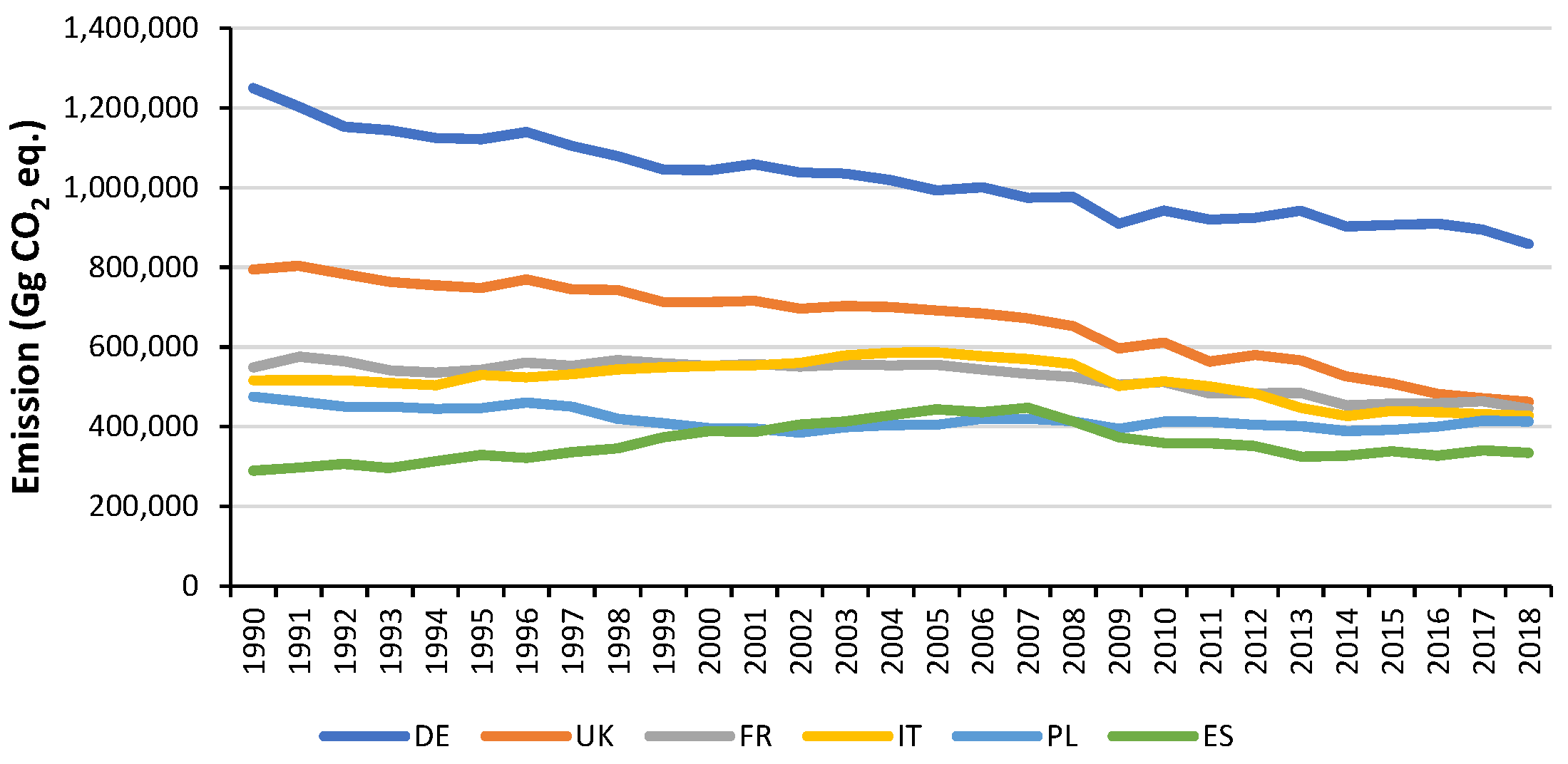
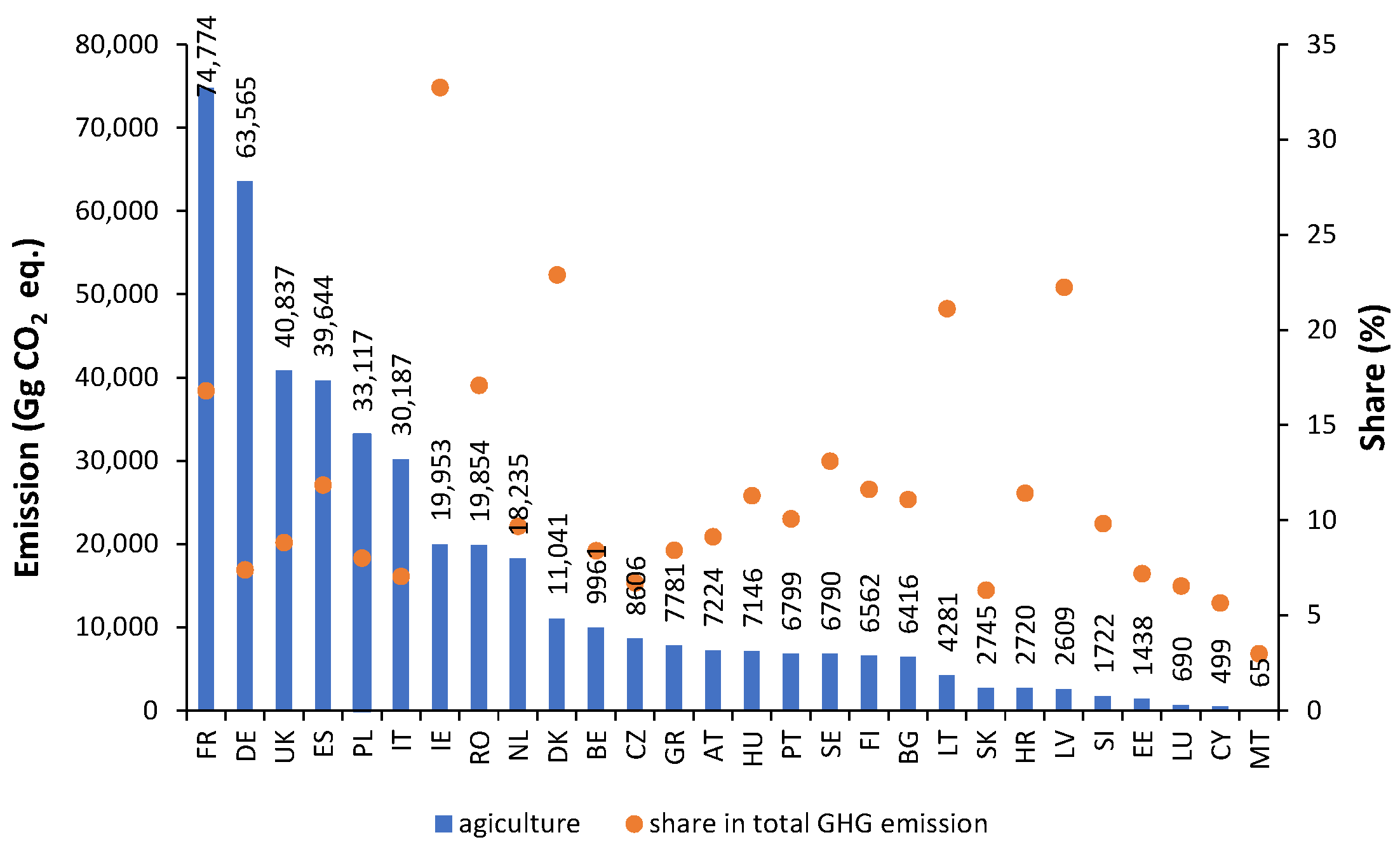


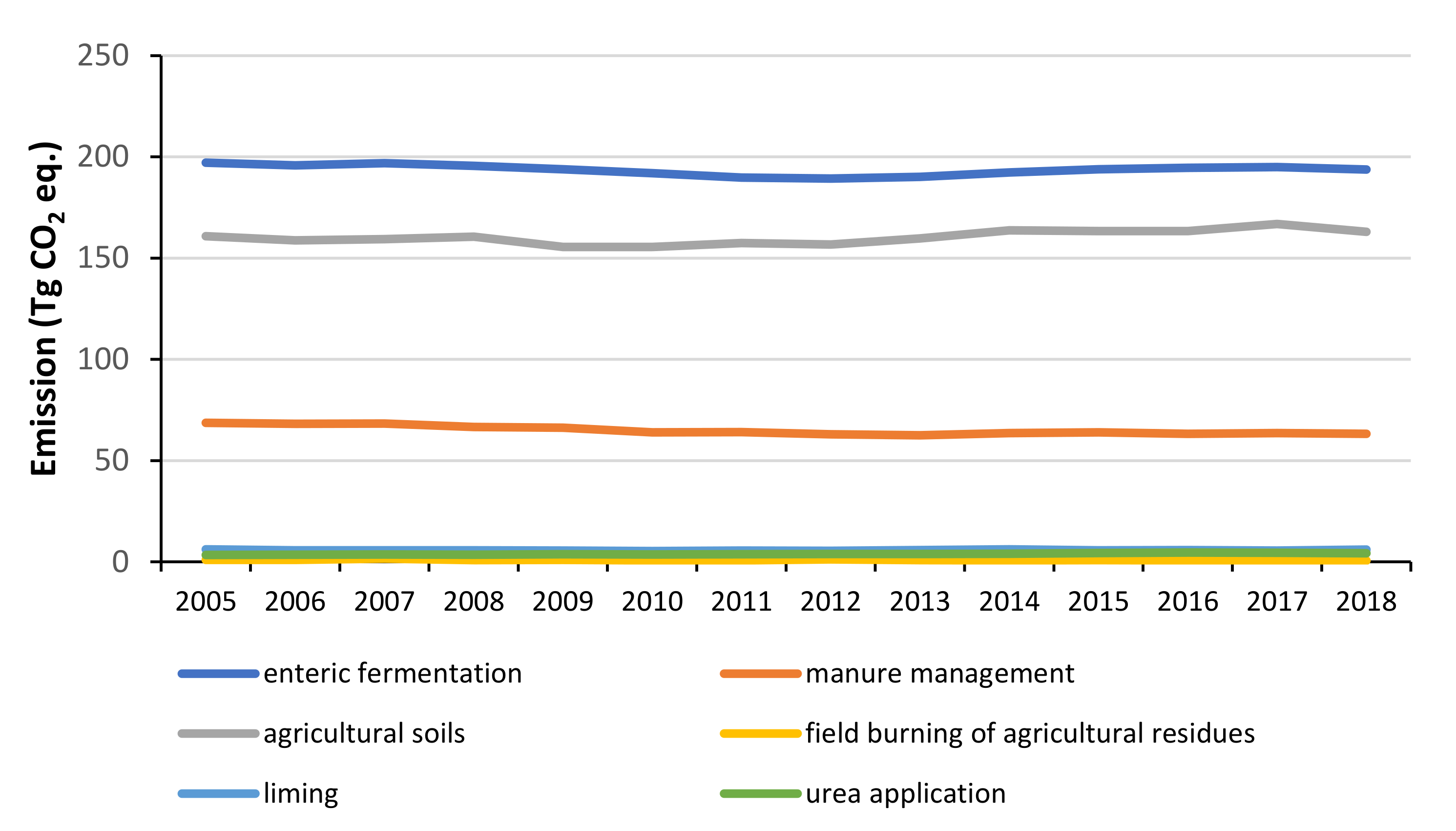
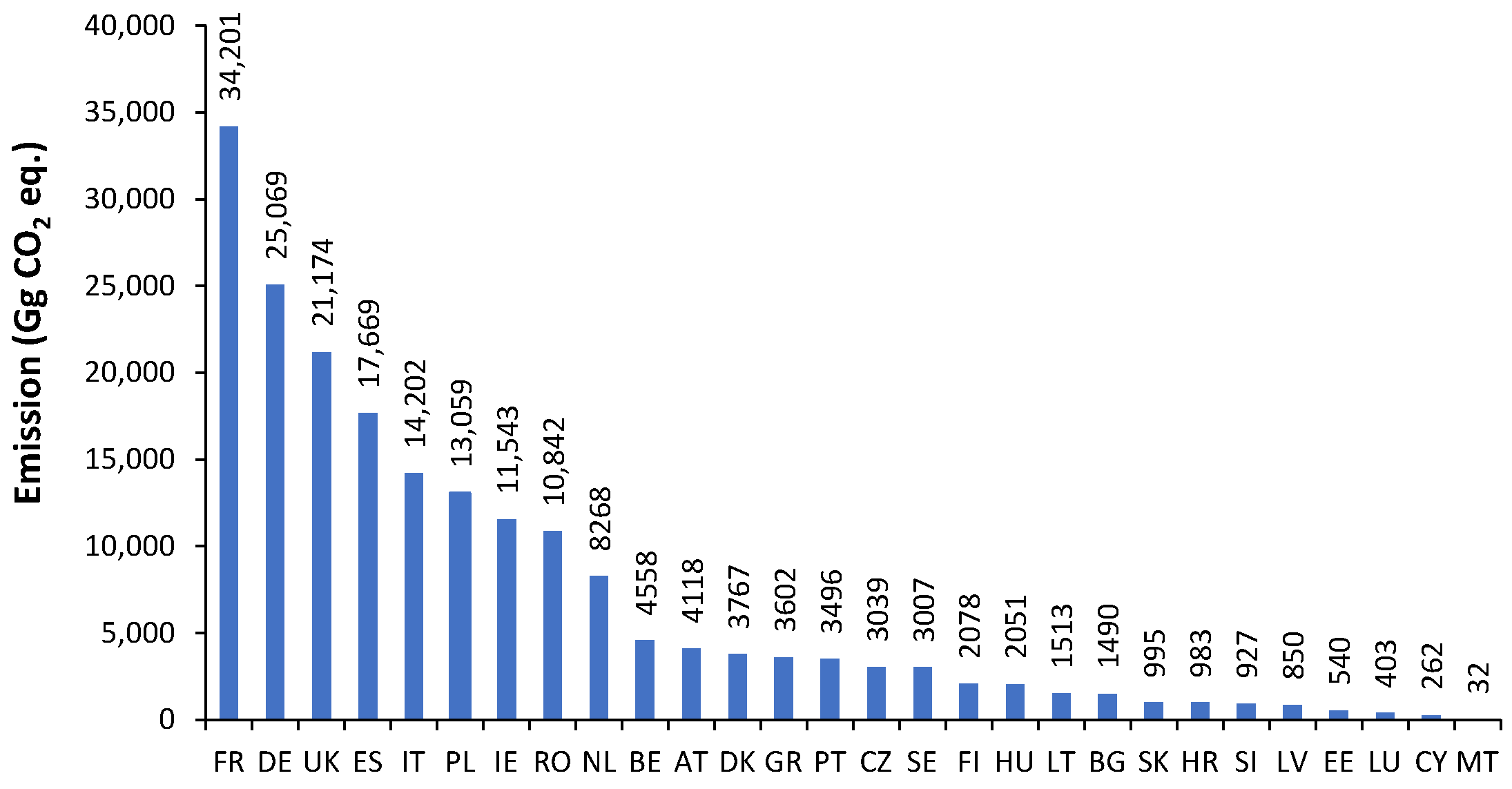


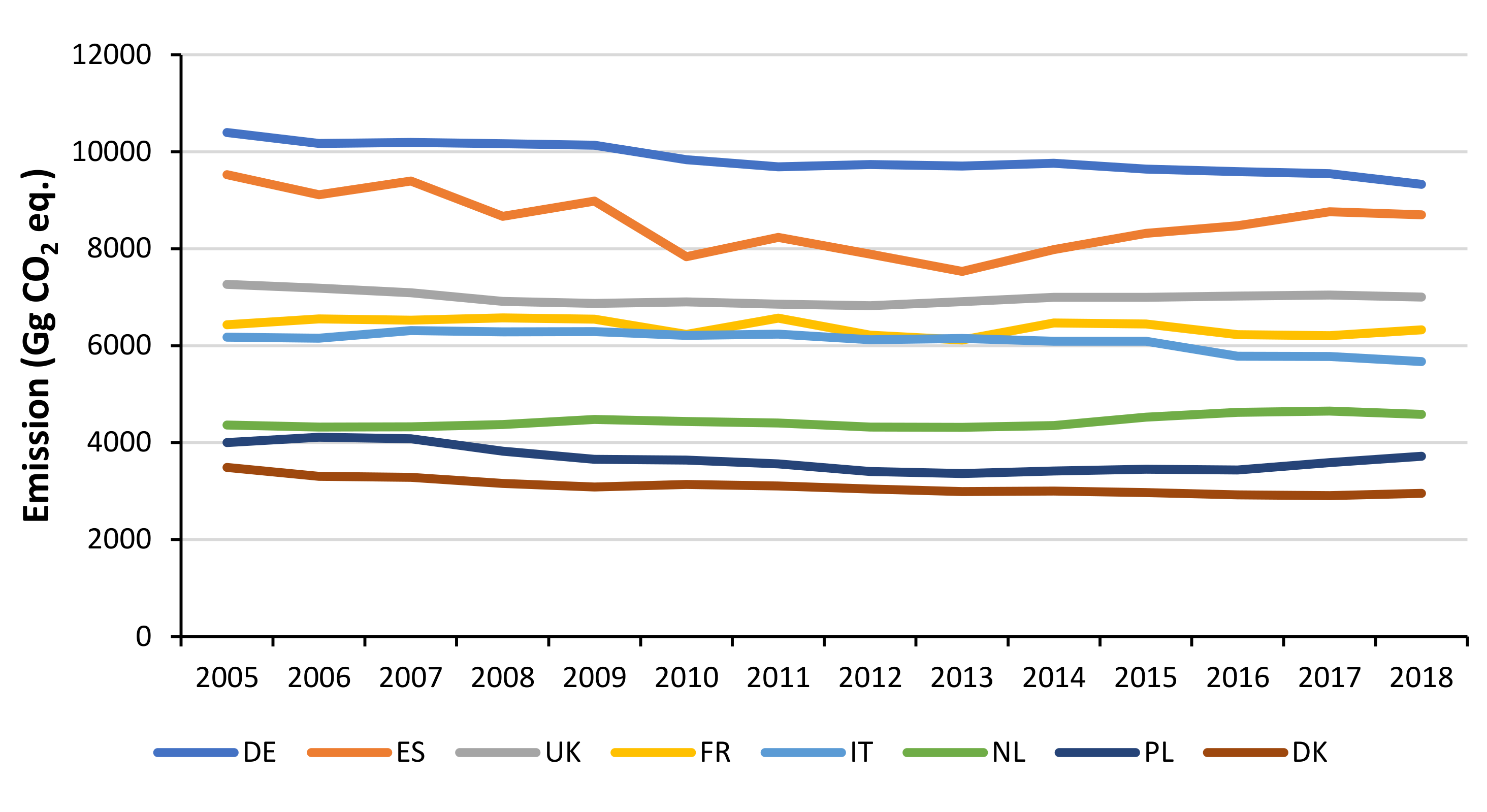
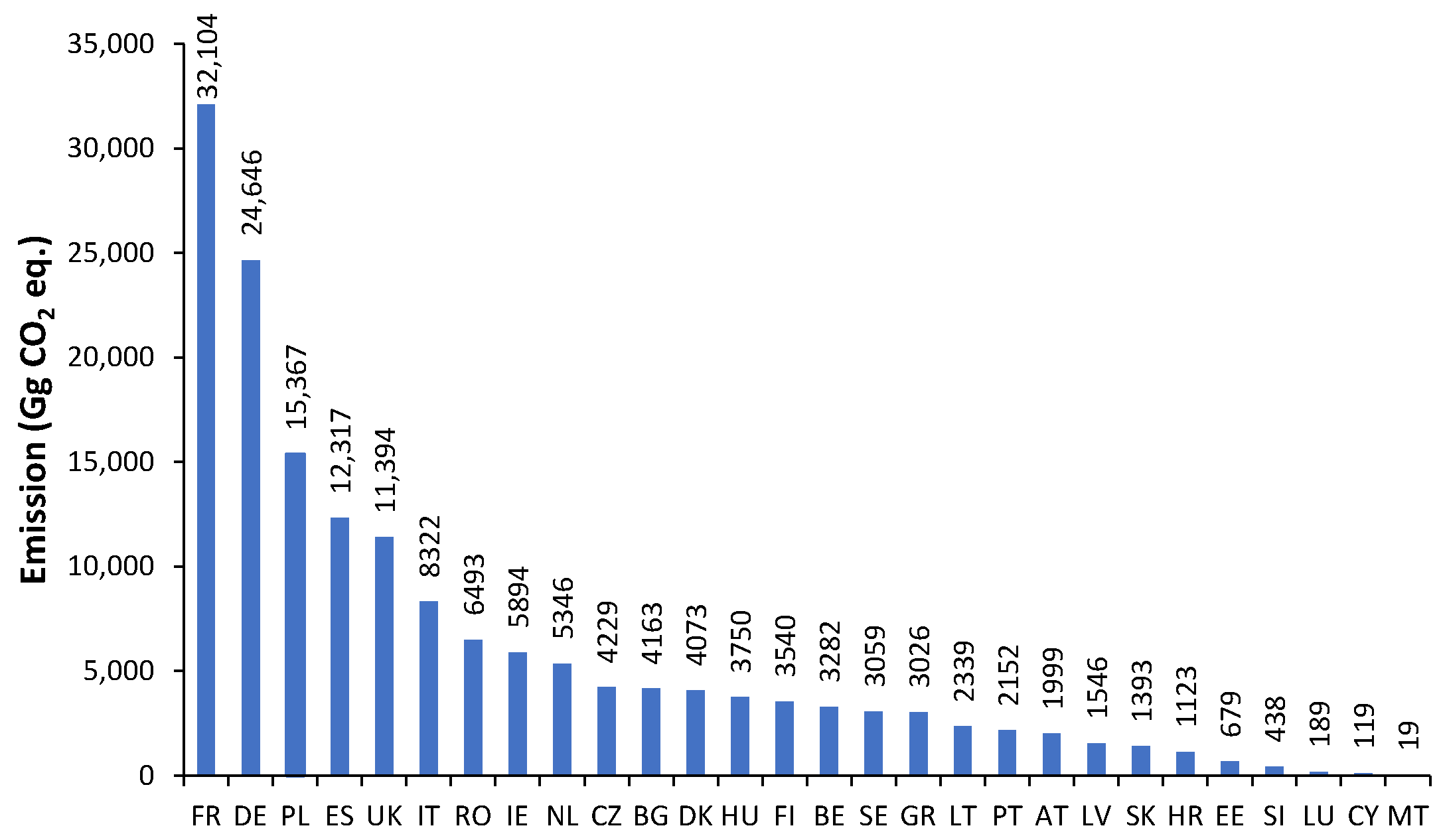
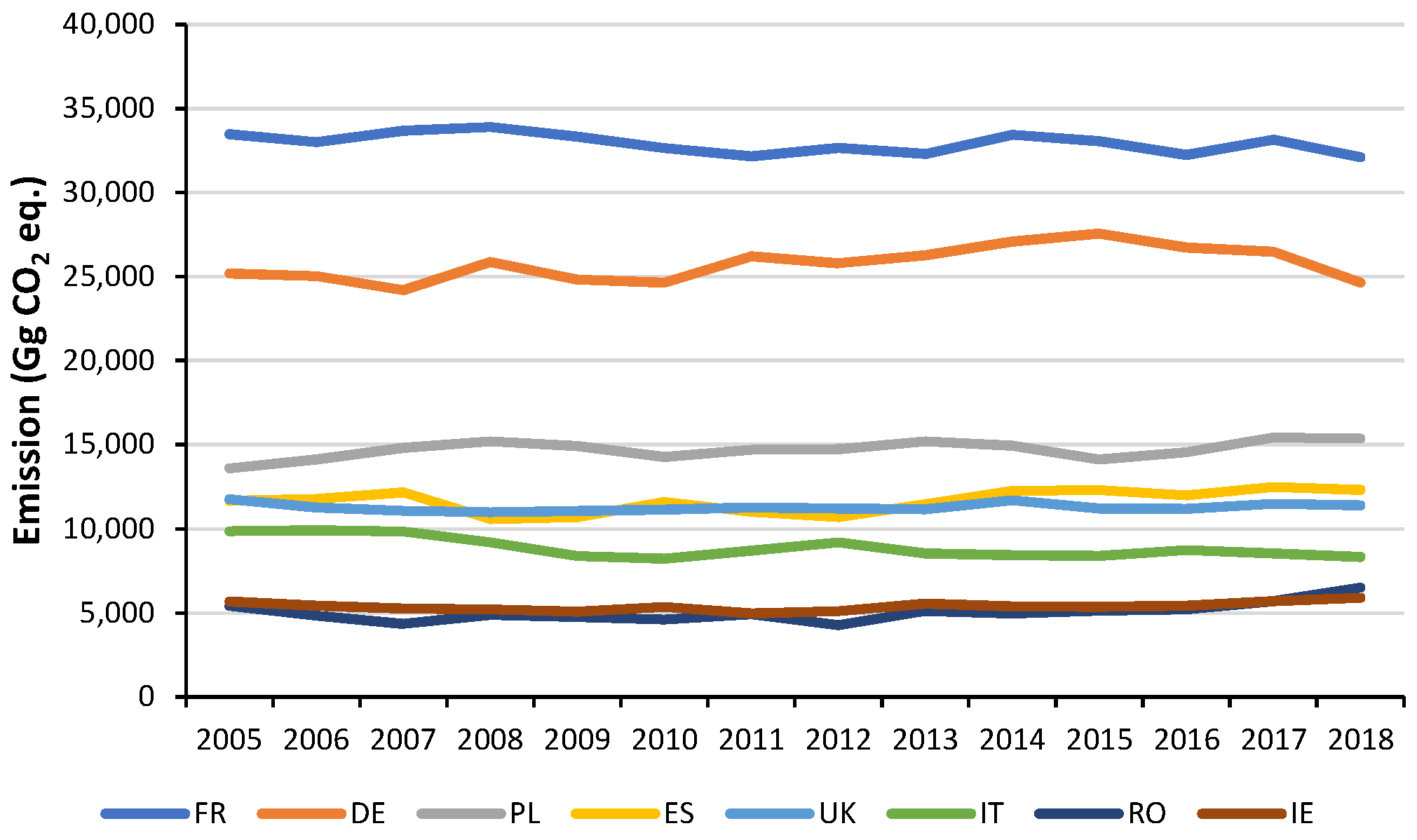

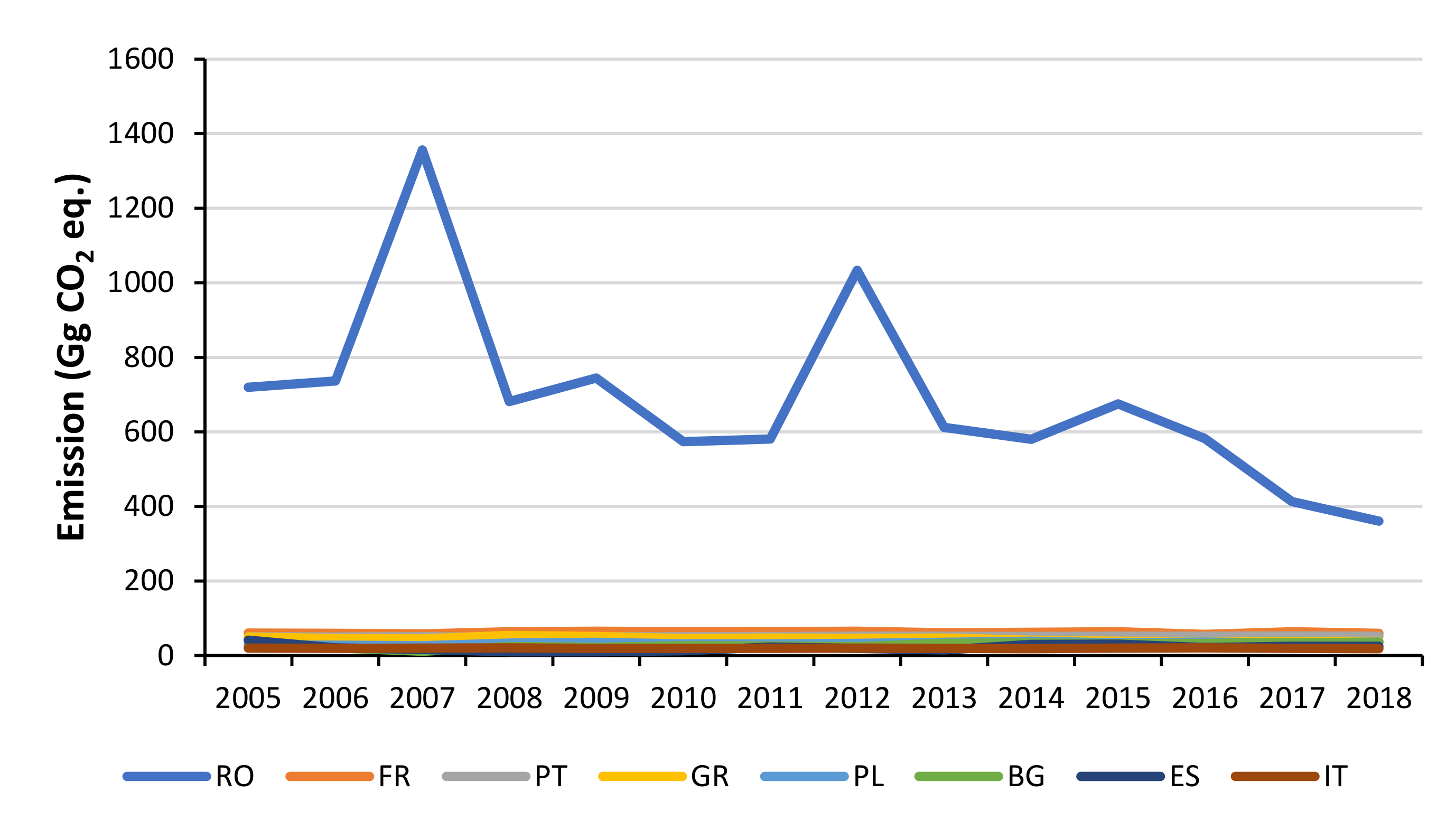

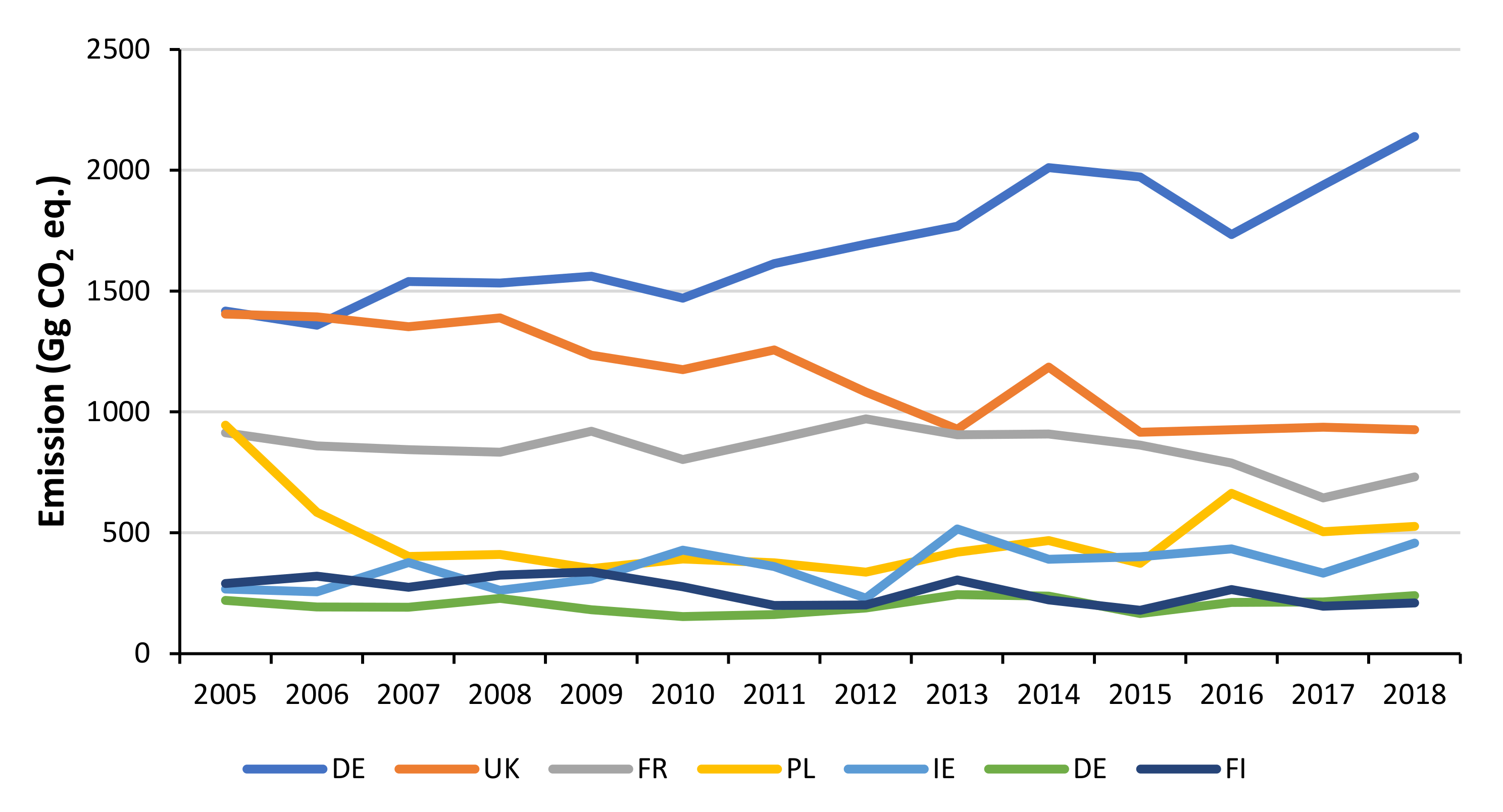


| Country | Agricultural GHG Emission in 2018 (Gg CO2 eq.) | Changes in Agricultural GHG Emissions for 2005–2018 (%) | GHG Emission Limits in 2020 Compared with 2005 GHG Levels (%) | Reduction of GHG Emissions in 2030 Compared with 2005 GHG Levels (%) |
|---|---|---|---|---|
| FR | 74,774.04 | −3.3 | −14 | −37 |
| DE | 63,564.89 | −1.0 | −14 | −38 |
| UK | 40,837.00 | −5.6 | −16 | −37 |
| ES | 39,643.76 | −3.2 | −10 | −26 |
| PL | 33,117.07 | 7.9 | 14 | −7 |
| IT | 30,186.58 | −5.8 | −13 | −33 |
| IE | 19,953.07 | 6.5 | −20 | −30 |
| RO | 19,854.03 | −6.1 | 19 | −2 |
| NL | 18,234.55 | −0.6 | −10 | −36 |
| DK | 11,041.26 | −2.0 | −20 | −39 |
| BE | 9960.88 | −3.8 | −15 | −35 |
| CZ | 8606.50 | 5.1 | 9 | −14 |
| GR | 7781.50 | −13.1 | −4 | −16 |
| AT | 7224.35 | 3.3 | −16 | −36 |
| HU | 7145.64 | 16.5 | 10 | −7 |
| PT | 6798.76 | 1.6 | 1 | −17 |
| SE | 6790.17 | −3.6 | −17 | −40 |
| FI | 6562.49 | 0.3 | −16 | −39 |
| BG | 6415.69 | 24.1 | 20 | 0 |
| LT | 4280.66 | 3.3 | 15 | −9 |
| SK | 2745.29 | 4.5 | 13 | −12 |
| HR | 2720.30 | −17.5 | - | −7 |
| LV | 2609.40 | 12.3 | 17 | −6 |
| SI | 1721.71 | −0.6 | 4 | −15 |
| EE | 1437.79 | 20.4 | 11 | −13 |
| LU | 690.44 | 9.8 | −20 | −40 |
| CY | 499.40 | −6.3 | −5 | −24 |
| MT | 65.46 | −13.7 | 5 | −19 |
Publisher’s Note: MDPI stays neutral with regard to jurisdictional claims in published maps and institutional affiliations. |
© 2021 by the authors. Licensee MDPI, Basel, Switzerland. This article is an open access article distributed under the terms and conditions of the Creative Commons Attribution (CC BY) license (https://creativecommons.org/licenses/by/4.0/).
Share and Cite
Mielcarek-Bocheńska, P.; Rzeźnik, W. Greenhouse Gas Emissions from Agriculture in EU Countries—State and Perspectives. Atmosphere 2021, 12, 1396. https://doi.org/10.3390/atmos12111396
Mielcarek-Bocheńska P, Rzeźnik W. Greenhouse Gas Emissions from Agriculture in EU Countries—State and Perspectives. Atmosphere. 2021; 12(11):1396. https://doi.org/10.3390/atmos12111396
Chicago/Turabian StyleMielcarek-Bocheńska, Paulina, and Wojciech Rzeźnik. 2021. "Greenhouse Gas Emissions from Agriculture in EU Countries—State and Perspectives" Atmosphere 12, no. 11: 1396. https://doi.org/10.3390/atmos12111396
APA StyleMielcarek-Bocheńska, P., & Rzeźnik, W. (2021). Greenhouse Gas Emissions from Agriculture in EU Countries—State and Perspectives. Atmosphere, 12(11), 1396. https://doi.org/10.3390/atmos12111396






